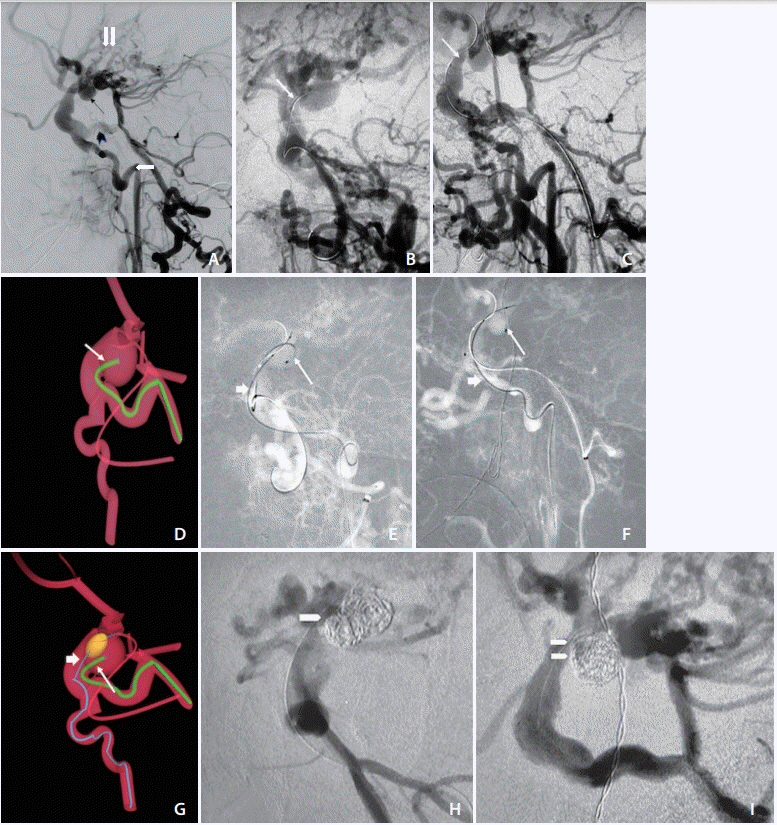Neurointervention.
2021 Jul;16(2):175-179. 10.5469/neuroint.2021.00073.
Scepter-Mini Balloon Assisted Coil Embolization of an Intracranial Arterial Aneurysm in a Child with PHACE Syndrome via a Persistent Trigeminal Artery
- Affiliations
-
- 1Depatment of Radiology, Neurosurgery and Neurology, University of Minnesota, Minneapolis, MN, USA
- KMID: 2517744
- DOI: http://doi.org/10.5469/neuroint.2021.00073
Abstract
- Cerebral vascular malformations constitute one of the key abnormalities in children with PHACE syndrome, which is characterized by Plaque like cutaneous hemangiomas, Posterior fossa abnormalities, arterial Cerebrovascular and Eye abnormalities, with or without Sternal clefts (PHACES when sternal clefts are present), and associated midline anomalies. Both moyamoya arteriopathy and intracranial aneurysms have been reported in children with this syndrome. Herein, we report the successful treatment of a growing left posterior-communicating artery aneurysm arising from an aberrant left internal carotid artery (LICA) with balloon assisted coiling (BAC) in a child with PHACE syndrome. We circumvented the limitations posed by the narrow caliber of the proximal LICA, by successfully navigating a coiling microcatheter from the basilar artery into the LICA via a persistent trigeminal artery. BAC was then achieved using a Scepter Mini balloon microcatheter for aneurysm neck remodelling.
Keyword
Figure
Cited by 1 articles
-
Balloon-Assisted Coil Embolization and Balloon Angioplasty for Post Subarachnoid Hemorrhage Vasospasm: Initial Experience with Scepter Mini Balloon
Ioannis Ioannidis, Antonis Adamou, Nikolaos Nasis, Marianna Vlychou, Nektarios Poullos
Neurointervention. 2022;17(2):110-114. doi: 10.5469/neuroint.2022.00171.
Reference
-
1. Heyer GL, Dowling MM, Licht DJ, Tay SK, Morel K, Garzon MC, et al. The cerebral vasculopathy of PHACES syndrome. Stroke. 2008; 39:308–316.
Article2. Frieden IJ, Reese V, Cohen D. PHACE syndrome. The association of posterior fossa brain malformations, hemangiomas, arterial anomalies, coarctation of the aorta and cardiac defects, and eye abnormalities. Arch Dermatol. 1996; 132:307–311.
Article3. Hadisurya J, Guey S, Grangeon L, Wieczorek D, Corpechot M, Schwitalla JC, et al. Moyamoya angiopathy in PHACE syndrome not associated with RNF213 variants. Childs Nerv Syst. 2019; 35:1231–1237.
Article4. Lv X, Jiang C, Li Y, Yang X, Wu Z. Endovascular treatment for pediatric intracranial aneurysms. Neuroradiology. 2009; 51:749–754.
Article5. Ghali MGZ, Srinivasan VM, Cherian J, Wagner KM, Chen SR, Johnson J, et al. Multimodal treatment of intracranial aneurysms in children: clinical case series and review of the literature. World Neurosurg. 2018; 111:e294–e307.
Article6. Jernigan S, Storey A, Hammer C, Riordan C, Orbach DB, Scott RM, et al. Moyamoya syndrome and PHACE syndrome: clinical and radiographic characterization of the intracranial arteriopathy and response to surgical revascularization. J Neurosurg Pediatr. 2019; 23:493–497.
Article7. Heyer GL, Millar WS, Ghatan S, Garzon MC. The neurologic aspects of PHACE: case report and review of the literature. Pediatr Neurol. 2006; 35:419–424.
Article8. Habib M, Manilha R, Khan N. Management of PHACES syndrome: risk of stroke and its prevention from a neurosurgical perspective. Eur J Paediatr Neurol. 2020; 26:39–45.
Article9. Mehta T, Hassan A, Masood K, Tekle W, Grande A, Tummala R, et al. The next step in balloon assisted endovascular neurosurgical procedures: A case series of initial experience with the Scepter Mini balloon microcatheter. Interv Neuroradiol. 2021; 27:298–306.
Article10. Oza VS, Wang E, Berenstein A, Waner M, Lefton D, Wells J, et al. PHACES association: a neuroradiologic review of 17 patients. AJNR Am J Neuroradiol. 2008; 29:807–813.
Article
- Full Text Links
- Actions
-
Cited
- CITED
-
- Close
- Share
- Similar articles
-
- Persistent Trigeminal Artery with a Cerebellar Branch and Trigeminal-Cavernous Fistula from Ruptured Aneurysm: Transarterial Coil Embolization
- Microcatheter-assisted Coil Embolization of Distal Vertebral Artery Wide-Necked Aneurysm: A Case Report
- Dual Stent-Assisted Coil Embolization for Fusiform Aneurysm Arising From Persistent Trigeminal Artery
- Balloon-Assisted Coil Embolization and Balloon Angioplasty for Post Subarachnoid Hemorrhage Vasospasm: Initial Experience with Scepter Mini Balloon
- Initial Experience with the New Double-lumen Scepter Balloon Catheter for Treatment of Wide-necked Aneurysms


